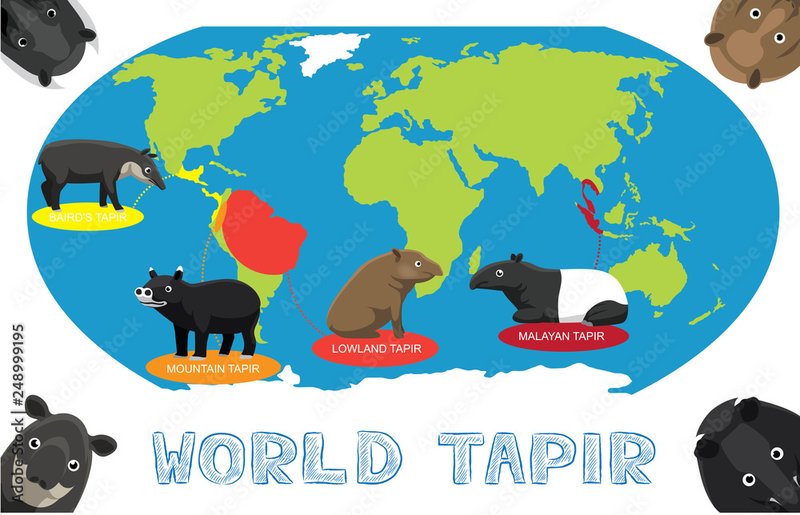
But where do they actually live? To answer this, let’s take a closer look at their habitat and distribution. Understanding where mountain tapirs roam gives us insight into their lives, their needs, and the environmental challenges they face. It’s like piecing together a puzzle that helps us appreciate these unusual animals just a bit more.
Understanding Mountain Tapir Habitat
Mountain tapirs are quite particular about where they call home. Generally, they inhabit the cloud forests and paramo regions of the Andes, primarily in Colombia, Ecuador, and northern Peru. Picture lush, misty forests teeming with life, where the vegetation is thick and the air is cool—these are the environments that mountain tapirs thrive in.
The high-altitude forests provide ample coverage and a variety of foods, including leaves, fruits, and tender plants. Mountain tapirs are herbivores, so a diet filled with diverse flora is crucial for their survival. Their preferred elevations range from about 2,800 to 4,200 meters (roughly 9,200 to 13,800 feet). That’s pretty high up! These elevations allow them to stay cool and avoid some of the predators that lurk in lower lands.
Interestingly, mountain tapirs are adapted to deal with the high humidity found in their cloud forest homes. This means their bodies are built to withstand not just the altitude but also the moisture that drapes everything in a soft, green blanket. Can you imagine wandering through such a mystical place? It’s easy to see why mountain tapirs have made it their home.
Geographic Distribution of Mountain Tapirs
Now that we have a grasp of their habitat, let’s talk about their geographic distribution. Mountain tapirs are primarily found in the *Western Andes* of Colombia and Ecuador, extending slightly into northern Peru. Their range has faced fragmentation due to human activities, which creates challenges for their survival.
You might be wondering how these animals manage in such a specific area. Well, mountain tapirs are not overly social. They tend to be solitary creatures, which allows them to roam around their designated areas without much overlap with others. However, this also means that when their habitats shrink, so do their options for finding mates and food.
Also, some areas within their range are protected as national parks, like the *Cajas National Park* in Ecuador. This provides a safer environment where they can thrive, but there are still pockets of habitat that are increasingly at risk due to urbanization and agriculture. It’s a balancing act, where conservation efforts play a critical role.
Climate and Environment Preferences
Mountain tapirs have a keen preference for specific climates. They thrive in cool, damp environments that are rich in biodiversity. The average temperature in their habitats can range from 10°C to 20°C (50°F to 68°F). This chillier climate is ideal for these animals, which are built to navigate through thick vegetation and rough terrains.
Their environment also includes a mix of tree cover and open spaces. While they enjoy the shade of trees, especially during the day, they also need areas where they can graze freely on grass and herbs. So, you’ll often find them in regions where dense forests transition into grasslands. This kind of mixed environment provides variety in their diet, which is essential for maintaining healthy tapirs.
Additionally, the altitude affects not just the temperature but also the type of flora available. The unique cloud forest ecosystem supports various plant species, all providing vital nutrition for mountain tapirs. This delicate balance of climate, environment, and food sources is what keeps them thriving in such challenging terrains.
Threats to Mountain Tapir Habitats
Despite perfectly fitting into their environments, mountain tapirs face numerous threats. One of the most significant challenges is habitat loss due to deforestation. As humans expand into the Andean region for farming, logging, and even urban development, the lush landscapes that tapirs rely on are disappearing.
Another threat comes from hunting. Although they are not the primary targets for many poachers, mountain tapirs can become victims simply because they are in the wrong place at the wrong time. This adds an additional layer of risk to their already precarious existence.
Finally, climate change is another concern. As temperatures rise and rainfall patterns shift, the cloud forests they depend on may become less hospitable. Some studies suggest that these animals might struggle to adapt quickly enough to the changing conditions. It’s a tough world out there, and these creatures need our help to survive.
The Role of Conservation Efforts
Conservation plays a vital role in protecting mountain tapirs and their habitats. Various organizations and governments have recognized the importance of safeguarding the environments where these animals thrive. Reserves and national parks, such as *El Angel Ecological Reserve* in Ecuador, help protect the landscapes that mountain tapirs call home.
These conservation areas not only provide a safe haven for tapirs but also help maintain the ecosystem as a whole. For instance, protecting mountain tapirs can ensure the survival of other species in the area, as they are an essential part of the food web. Less damage to their habitats can create better conditions for biodiversity, which benefits all the creatures living there.
Community-based conservation is another approach that emphasizes working with local populations. Educating people about the importance of mountain tapirs can create a sense of pride and responsibility toward preserving their habitats. When locals understand that these animals contribute to the health of the environment, they are more likely to help in protecting them.
What Can You Do to Help?
You might be thinking, “That’s great, but what can I actually do to help mountain tapirs?” Well, even small actions can contribute to larger conservation efforts. Here are a few ideas:
- Support Conservation Organizations: Look for groups focused on protecting wildlife and the environment in the Andes. Donations can help fund critical projects.
- Spread Awareness: Share information about mountain tapirs on social media or within your community. The more people know, the more likely they are to care.
- Practice Sustainable Living: Being conscious about your consumption and supporting sustainable practices can help minimize environmental impact globally.
- Participate in Local Conservation Efforts: Many areas have local initiatives that focus on conservation. Getting involved can make a real difference.
Every little bit helps. Mountain tapirs may be far away, but that doesn’t mean we can’t be a part of their story.
Understanding where mountain tapirs live and how they adapt to their unique habitats helps us appreciate their importance in the Andean ecosystems. Their survival is intricately tied to the health of the forests and grasslands they inhabit, which are under constant threat. By focusing on conservation efforts and raising awareness, we can all play a part in protecting these incredible creatures. After all, every species has its role, and the mountain tapir is no exception. Let’s make sure their story continues for generations to come.

